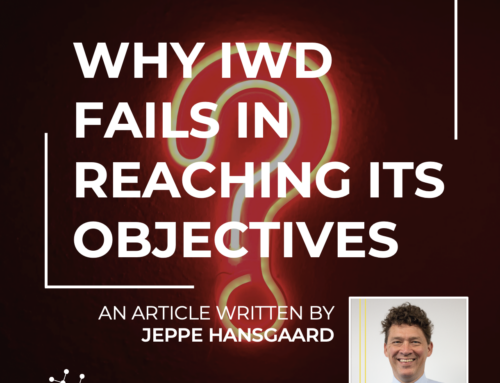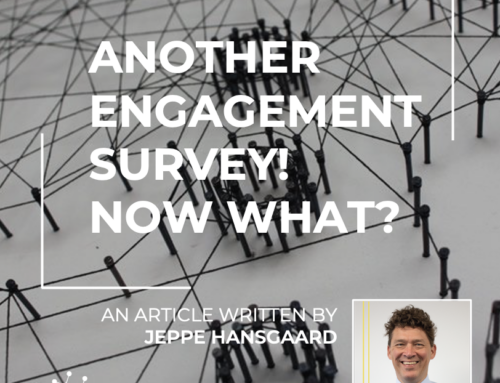FROM OUR CEO
Three Steps to Connect to The Evidence of the Grapevine
November 22nd, 2023 | From our CEO
One of my favorite songs is “I heard it through the Grapevine”. Especially, I like the part, where Marvin Gaye sings “It took me by surprise…”
Most top executives would be taken by surprise, if they knew what was going on in their organizations – but unlike Marvin Gaye in the song – top executives do not have the privilege of being able to listen to the grapevine.
Top executives are in fact disconnected from the organizational reality in the organizations they are supposed to lead! It is hard to imagine a bigger risk for a top executive. In this article, I will share three steps top executives can take to avoid the risk of being taken by surprise.
No Top Executive Can Risk Being Taken by Surprise!
Top executives in global disperse organizations are disconnected from the problems faced in the organization. The reasons are many, but one we often see is called the “Water Melon Effect”. It is what happens, when people fear to tell the executives how the situation really is, and therefore color all their KPI’s green – as if everything is ok – although this is not the case. If somebody were digging a bit deeper in the KPI, they would discover it is all red… just like a Water Melon (Gavett, 2013)
The result is a lot of top executive decision making is taking place without knowing the problems faced by the organization. Many top executives know they are facing this issue, but they do not know, how to get access to the information they need.
Firstly, they do not know WHO they should ask for the “truth” in their organizations.
Secondly, they might not get told the “truth”, if they ask for it. Trust in executives is at an all-time low, so why share the “truth” with them.
What Can Top Executives Do to Avoid the Risk?
What can top executives do to connect to the evidence of the grapevine? The complexity of organizations and the environments they navigate in is often overwhelming. But… Overwhelming complexity is not an excuse for trying to understand!
The direct connection between the top and the bottom of organizations must be re-established! Top executives must know the truth of the grapevine. They must seek conversations with and exposure to employees throughout the organizations.
Otherwise they cannot steer their organizations!
Three Steps to Connect to the Right Few
In my opinion top executives should connect to the right few people in the organization.
It is like marketing – just inside organizations. Find out who drives the sense making and the perceptions, and then work from there. It is about three percent of the employees that shape the perceptions of all other employees (Lalleman, 2017).
Specifically, the top executives should follow these three steps:
- Step 1: Peer-identify, who drives conversations and sense making
- Step 2: Establish a trustful conversation channel with those identified
- Step 3: Create a continuous listening mechanism
How do I Peer-identify Those Critical Employees?
Look for likeability. Likability beats being competent in terms of influence. If people have a choice between a competent jerk and a lovable fool, then most people will talk to the lovable fool. This dynamic also applies to organizations. Very often likability is also connected to being trustworthy and a good listener.
When people have a choice between two likeable persons, they go for the one they find most competent.
Remember you cannot judge other people’s perception of, who they find competent and likeable. You need to peer-identify them by asking your employees.
How do I Integrate This into My Communications Strategy?
You can guide your work through the following model.

Leaders are of paramount importance. They need to articulate and communicate the “Why” in a precise and engaging manner. In the leadership meetings, in the town hall meetings, on the intranet – and through all other corporate communication channels. This is the upper left quadrant. It is formal communication and it is structured.
Leaders also must be role models. If the organization is running a collaboration program, the leader must demonstrate collaborative behavior, and if it is a Diversity & Inclusion program the leader must be authentically inclusive. This is the lower left quadrant. It is still formal – the leaders are also leaders when they walk around – but it is unstructured.
The new part lies in the left quadrants.
In the upper right quadrant, you work with the peer-identified employees. The best way to engage them is through informal conversations. We sometimes call them “fireside chats”. In these conversations, you should share what is going on in the organization, let them ask questions, and even allow them to alter the plans here and there.
This part works best, when a discipline for regular trustful conversations and listening is established. It is informal, but still structured.
The peer-identified employees will, when you succeed, be your most powerful advocates at “the water cooler”, and facilitate the sense making for all their colleagues. The sense making that is needed to get to change. This takes place in the lower right quadrant. It is informal, and it is not structured.
If this is in place, even top executives do not have to run the risk of not being able to listen to the evidence at the grapevine. They can sing along on “It took me by surprise…” rather than let the song scare them.
FROM OUR CEO
Three Steps to Connect to The Evidence of the Grapevine
November 22nd, 2023 | From our CEO
One of my favorite songs is “I heard it through the Grapevine”. Especially, I like the part, where Marvin Gaye sings “It took me by surprise…”
Most top executives would be taken by surprise, if they knew what was going on in their organizations – but unlike Marvin Gaye in the song – top executives do not have the privilege of being able to listen to the grapevine.
Top executives are in fact disconnected from the organizational reality in the organizations they are supposed to lead! It is hard to imagine a bigger risk for a top executive. In this article, I will share three steps top executives can take to avoid the risk of being taken by surprise.
No Top Executive Can Risk Being Taken by Surprise!
Top executives in global disperse organizations are disconnected from the problems faced in the organization. The reasons are many, but one we often see is called the “Water Melon Effect”. It is what happens, when people fear to tell the executives how the situation really is, and therefore color all their KPI’s green – as if everything is ok – although this is not the case. If somebody were digging a bit deeper in the KPI, they would discover it is all red… just like a Water Melon (Gavett, 2013)
The result is a lot of top executive decision making is taking place without knowing the problems faced by the organization. Many top executives know they are facing this issue, but they do not know, how to get access to the information they need.
Firstly, they do not know WHO they should ask for the “truth” in their organizations.
Secondly, they might not get told the “truth”, if they ask for it. Trust in executives is at an all-time low, so why share the “truth” with them.
What Can Top Executives Do to Avoid the Risk?
What can top executives do to connect to the evidence of the grapevine? The complexity of organizations and the environments they navigate in is often overwhelming. But… Overwhelming complexity is not an excuse for trying to understand!
The direct connection between the top and the bottom of organizations must be re-established! Top executives must know the truth of the grapevine. They must seek conversations with and exposure to employees throughout the organizations.
Otherwise they cannot steer their organizations!
Three Steps to Connect to the Right Few
In my opinion top executives should connect to the right few people in the organization.
It is like marketing – just inside organizations. Find out who drives the sense making and the perceptions, and then work from there. It is about three percent of the employees that shape the perceptions of all other employees (Lalleman, 2017).
Specifically, the top executives should follow these three steps:
- Step 1: Peer-identify, who drives conversations and sense making
- Step 2: Establish a trustful conversation channel with those identified
- Step 3: Create a continuous listening mechanism
How do I Peer-identify Those Critical Employees?
Look for likeability. Likability beats being competent in terms of influence. If people have a choice between a competent jerk and a lovable fool, then most people will talk to the lovable fool. This dynamic also applies to organizations. Very often likability is also connected to being trustworthy and a good listener.
When people have a choice between two likeable persons, they go for the one they find most competent.
Remember you cannot judge other people’s perception of, who they find competent and likeable. You need to peer-identify them by asking your employees.
How do I Integrate This into My Communications Strategy?
You can guide your work through the following model.

Leaders are of paramount importance. They need to articulate and communicate the “Why” in a precise and engaging manner. In the leadership meetings, in the town hall meetings, on the intranet – and through all other corporate communication channels. This is the upper left quadrant. It is formal communication and it is structured.
Leaders also must be role models. If the organization is running a collaboration program, the leader must demonstrate collaborative behavior, and if it is a Diversity & Inclusion program the leader must be authentically inclusive. This is the lower left quadrant. It is still formal – the leaders are also leaders when they walk around – but it is unstructured.
The new part lies in the left quadrants.
In the upper right quadrant, you work with the peer-identified employees. The best way to engage them is through informal conversations. We sometimes call them “fireside chats”. In these conversations, you should share what is going on in the organization, let them ask questions, and even allow them to alter the plans here and there.
This part works best, when a discipline for regular trustful conversations and listening is established. It is informal, but still structured.
The peer-identified employees will, when you succeed, be your most powerful advocates at “the water cooler”, and facilitate the sense making for all their colleagues. The sense making that is needed to get to change. This takes place in the lower right quadrant. It is informal, and it is not structured.
If this is in place, even top executives do not have to run the risk of not being able to listen to the evidence at the grapevine. They can sing along on “It took me by surprise…” rather than let the song scare them.
Related articles
Share article
Share article








